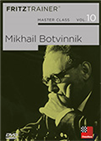A complex character
By Carl Strugnell. Excerpt from ‘Remembering Dima’ (CHESS Magazine, September 2021)
 A year has passed since the disappearance of my good friend and trainer, Dimitri Svetushkin. And so it is not without a sense of regret that I share with you some of his games on this day.
A year has passed since the disappearance of my good friend and trainer, Dimitri Svetushkin. And so it is not without a sense of regret that I share with you some of his games on this day.
Dima was a complex character, and his mood could swing from gloom and doom to wholehearted laughter in the space of an instant. An over-thinker would probably best describe him, but he was also an accomplished Triathlon athlete. He was into metaphysics, spoke half a dozen languages, and enjoyed a pint or two after the game (“a car needs to be oiled in order to function properly” he would tell me).
For reference, I wrote an article for CHESS entitled ‘Learning with Dima’ in April 2017, that you might want to inspect closely if what follows grabs your attention. In it I explained how he made me aware of a tactical algorithm handed down to him by the legendary Moldovan trainer Chebanenko, that is practically unheard of (and I asked around to make sure).
Most players who seek progress want a formula, but in reality, on a subconscious level, they desire an improved version of what they are already doing. Very few can scrap everything and start from scratch à la Korchnoi. That’s the bad news. The good news is that those who will allow themselves to be intrigued are in for a treat and won’t look back.
The algorithm itself is quite easy to grasp, though it needs a lot of practice before it becomes a reflex. It’s basically a form of extreme prophylaxis based on a semantic overinterpretation of the word ‘hanging’. A hanging or tactical weakness in Russian would be any unprotected piece (a loose piece), be it attacked or not, but not only... It is also any piece which is attacked as many times as it is defended. Of course, on its own this is not enough to make you start winning games, but used as a preliminary look at the board without judgement, it can help in a number of ways.
First off, if done with consistency, one-move blunders should vanish altogether. If you know where your tactical weakness is, you are expecting the opponent’s visit. More generally, it will help with any type of tactic (and I recommend you try using this method with a tactics book in hand, to witness how easy solutions are to find when you know where to look), but it will also give you a direction where to coordinate your pieces (Yusupov’s basic definition of coordination: pieces aim at the same spot).
I met Dima in 2013 in Cappelle, and some way mid-tournament we were paired together.
Svetushkin, Dmitry (2612) - Strugnell,Carl (2305)
29th Open Cappelle la Grande FRA (3.46), 25.02.2013
[Carl Strugnell]
[You can also follow the moves in the dynamic replayer below.]
1.e4 e5 2.Nf3 Nc6 3.Bb5 a6 4.Ba4 Nf6 5.0-0
There are a few moments where White can choose to play d3.
[5.d3 immediately is basically a way of refusing the Open variation (5...Nxe4). On the downside, it gives Black the choice of where to play his king’s bishop: for example 5...d6 (Or 5...b5 6.Bb3 Bc5 is now totally sound.) 6.c3 g6]
5...Be7 6.d3!
Now that we know the bishop’s address, White implements his slow plan. Its growing popularity is turning this sideline into one of the main lines of the Closed Spanish.
6...d6
The second move.
[The principled 6...b5 7.Bb3 d6 gives White a target of Black’s queenside pawns. Not knowing so much theory, I was looking for a quiet time.]
7.c4!?
 Our experts show, using the games of Botvinnik, how to employ specific openings successfully, which model strategies are present in specific structures, how to find tactical solutions and rules for how to bring endings to a successful conclusion
Our experts show, using the games of Botvinnik, how to employ specific openings successfully, which model strategies are present in specific structures, how to find tactical solutions and rules for how to bring endings to a successful conclusion
Dima always had his own ways of diverting from the trodden path. When I first saw the move over the board, I believed he wasn’t taking me seriously; another GM confirmed this feeling in words in the postmortem. Only, this is simply not the case. Here White makes an opportunity out of the unplayed ...b5 to create a bind. After normal development, d3-d4 will ensure he gets a space advantage.
7...Bg4
[Play can otherwise continue 7...0-0 8.h3 Nd7 9.Nc3 Nc5 (aiming for ...Ne6-d4) 10.Bxc6 bxc6 11.d4 exd4 12.Nxd4 Bd7 13.Be3 Bf6 14.Qc2 with an edge for White.]
8.Be3 0-0 9.Nbd2 Nd7 10.h3 Bxf3
Believing the bishop to be too restricted by the enemy pawns in case of retreat, I traded, with the intention to bring the battle around the d4-square.
11.Nxf3 Bf6 12.b4!
Typical Dima. After a scan of the position, the main tactical weaknesses in the black camp reveal themselves as b7 and c6 (one is unprotected, the other ‘hanging’, that is to say it is attacked as many times as it is defended). The text represents the best way to press where it is sore.
12.b4 might not be objectively the best move, but it is a clearcut example of his style of play.
12...b5
An attempt to complicate matters, though the cure is worse than the disease
[Be that as it may, after 12...Nxb4 13.Rb1 a5 14.a3 Na6 15.Bxd7 Qxd7 16.Rxb7 a4 17.Qb1 Nc5 18.Bxc5 dxc5 the computer suggests the advantage is only minor, though to the human eye the quality of our respective minor pieces tells another story. The secret might well lie in there being no easy outpost for the knight. In any case Black remains passive.]
13.cxb5 axb5 14.Bxb5 Nxb4 15.a3 Na6
It would seem, with his knight heading to c5, that Black is weathering the storm; nothing could be further from the truth.
16.Bc6!
Black’s rook now finds itself in a predicament.
16...Rb8 17.Ba7 Ndc5
[If 17...Rb2 18.Qc1 Rb3 19.Qc4 Ndc5 20.Rfb1 Black’s pieces find themselves in a bit of tangle, and White’s passed a-pawn serves as an insurance policy.]
18.Qc2 Rc8 19.a4 Ra8
A change of heart, realising the inevitable is bound to come.
20.Bxc5 Nxc5 21.Bxa8 Qxa8 22.Qc4 g6 23.a5
23...Qa7
[23...Rb8 24.a6 Qa7 25.Ra2 Rb6 Black’s knight is hanging (attacked once, defended once). To illustrate what this type of evaluation can yield, there is the instructive 26.d4 which might not have made it as a candidate move had there not been something to prompt our thoughts in that direction: 26...exd4 (Or 26...Rxa6 27.Rfa1!) 27.e5! (the point) 27...Be7 (27...Bg7 28.Ng5 wins.) 28.Nxd4 Rxa6 29.Nc6!]
24.Ra2 Rb8 25.d4 Nd7 26.dxe5 Nxe5 27.Nxe5 Bxe5 28.Kh1 c5 29.f4 Bd4 30.f5 Be5 31.fxg6 hxg6 32.g4 Rf8 33.Raf2
I lost faith: a6 is coming, White sacrifices everything on f7 and the bishop remains helpless at stopping the pawn promotion. Not my best performance by any account, but a nice demonstration of Dima’s positional mastery and risk-free approach. 1-0
Hanging pieces
Excerpt from Carl Strugnell’s piece ‘Learning from Dima’ (CHESS Magazine, April 2017)
Strugnell,Carl - Le Roux,Jean-Pierre
4NCL Birmingham, 2016
[Carl Strugnell]
 On this DVD Dorian Rogozenco, Mihail Marin, Oliver Reeh and Karsten Müller present the 8. World Chess Champion in video lessons: his openings, his understanding of chess strategy, his artful endgame play, and finally his immortal combinations.
On this DVD Dorian Rogozenco, Mihail Marin, Oliver Reeh and Karsten Müller present the 8. World Chess Champion in video lessons: his openings, his understanding of chess strategy, his artful endgame play, and finally his immortal combinations.
The first thing Dmitri Svetushkin realised about my game was that I had no idea what a hanging piece was.
33.Be1?
Jean-Pierre, ‘JP’ to his friends, told me off after the game: “But, Carl, at this point in the game you have to have everything protected, you need to be ultra solid. No playing moves like Be1; it’s just not permitted. If I would be playing an IM, I would have lost this game for sure.”
I am lucky my chess friends know my keenness for honesty, however hurtful. Chess is, after all, a ruthless universe, and those who can’t take criticism should take up knitting instead (over 10 years ago another friend told me he felt he had to stop analysing with me out of fear of regression – worse than a punch in the stomach!). However, the problem with JP’s definition is that I had not heard anything like it before, so could not associate it with anything nor categorise it. It floated in my mind for some time and then disappeared to become a vague memory.
[As such, I never really did learn after the game why 33.Bd2! would have been so much stronger.]
33...c4 34.Rd4
[34.Nd6! is still better for White, but that is not the point.]
34...Qxd5 35.Rxd5 Nc6 36.Rc5?!
[At least I should play 36.g3; Or, even better, 36.Kf2! c3 37.bxc3 b3 38.Rb5 Rb8 39.c4 which is simply unclear.]
36...Nd4
A hanging piece isn’t a piece that you leave en prise, as in a blunder; it is a piece that is attacked as many times as it is defended, and so it becomes a potential weakness of the tactical sort. That is the Russian term: ‘tactical weakness’ goes a million miles further than the ambiguous term ‘hanging’.
The hanging pieces here are the bishop on e1, the e4-knight, and the pawns on b2 and f4. The rook on c5 attacked by a lesser piece will also serve to gain Black a tempo. In short, none of my pieces have any sense of danger.
37.Kf2?
Too late for this now.
[37.Bd2 was required.
And note too the possibility of 37.g3 f6!! There is no better way to realise the true weakness of hanging pieces than confronting this type of move.]
37...Ne6 38.Rxc4 Nxf4 39.Nd6 Nd3+ 40.Ke2 Rxe5+
41.Kxd3 Rxe1 0-1
Links


















 A year has passed since
A year has passed since 




